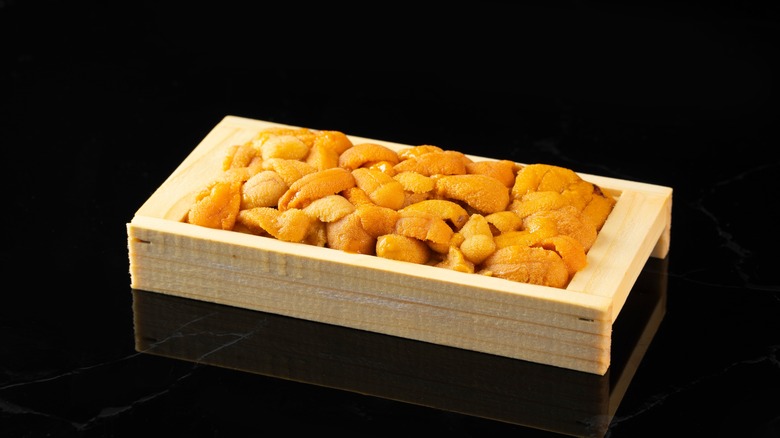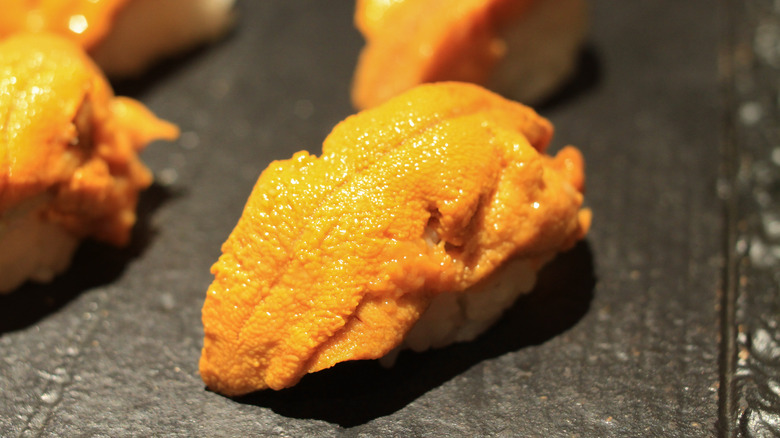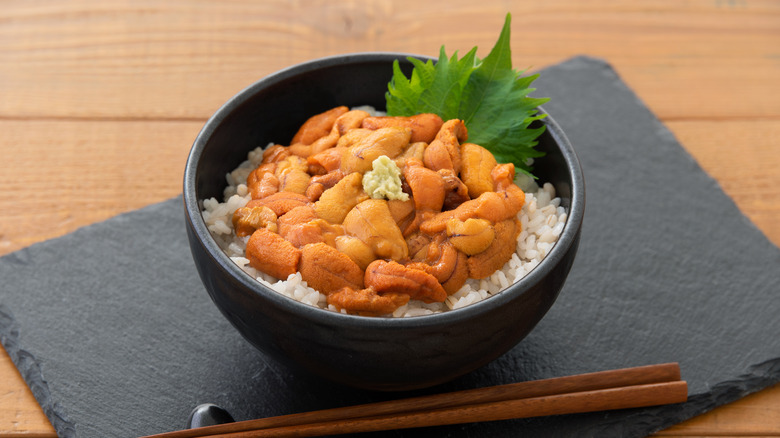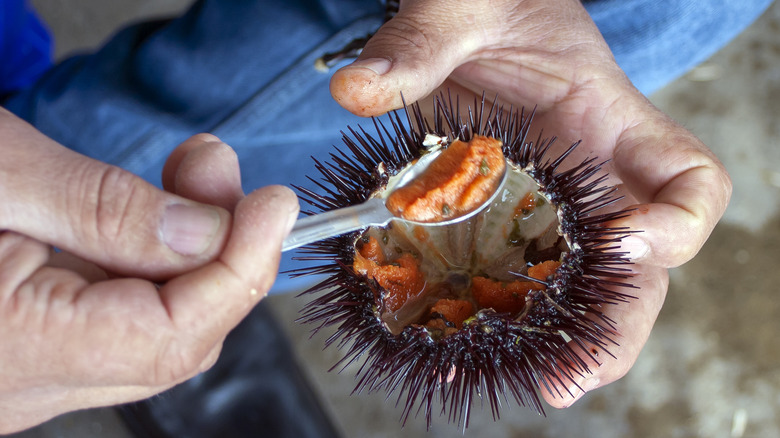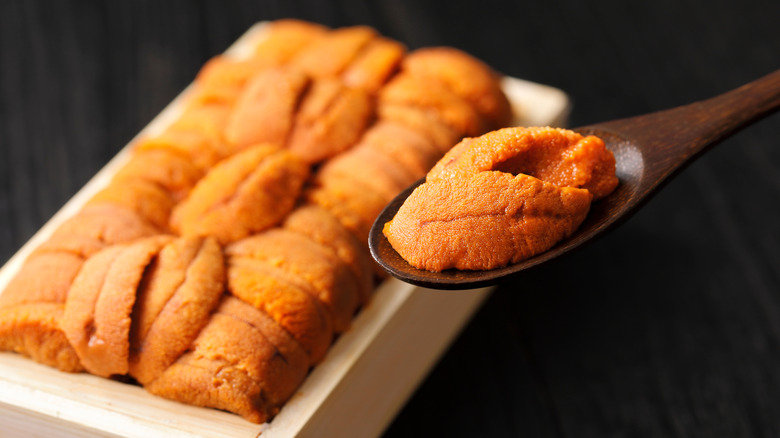What Is Uni And How Do You Eat It?
From caviar, to scallops and lobster, there are a ton of seaborn foods considered a delicacy. With freshness paramount to the food's enjoyment, it's vital to seek out these oceanic treasures close to the source. Not only maximizing flavor, eating fresh seafood generates less waste, optimizes nutrition, and aids the local fishing economy, notes La Marea.
And there's no place to sample the fresh bounty of the ocean quite like Japan. With an expansive coastline satiated with diversity and a commitment to freshness, the country popularized sushi for a good reason, per Taste of Japan. Sure, there's tuna and salmon, but past the deservedly popular favorites, seek out other delicious gems at the sushi bar: freshwater eel called unagi, immature sardines nama-shirasu, and the highly sought-after uni. Reaching prices of $400 per kilogram (via Culture Trip), this sea urchin delicacy is undeniably something special. So let's dive into what this delicious seafood is all about.
What is uni?
Uni, the Japanese word for sea urchin, is the only edible part of the spiny ocean-dweller. Although often mislabeled as the roe, it's actually the creature's reproductive organs, notes Taste. However, don't let such anatomical descriptions dissuade you — the food is sought after for a good reason. Uni is rich and creamy, with a texture reminiscent of a good Pâté , but lighter. The flavor is lightly salty, with oceanic touches reminiscent of other high-quality seafood. To highlight the best of this food, it's necessary to keep it as fresh as possible, notes Tensuke Market.
Usually served as a sushi type, uni is typically eaten raw in Japan. However, it can also be integrated into dishes, such as a sauce for pasta. While mostly associated with Japanese cuisine, uni is eaten around the world, including in Chile, the Mediterranean, and increasingly, in the U.S., via Travel Gluttons. There are many different types of the sea creature with varying textures and flavors. They're organized by grade, with the top category exhibiting a firm consistency and sweet taste, explains sushifaq.com.
Cooking and selecting uni
Uni is undeniably expensive; however, a small amount delivers a punch of flavor– only an ounce is necessary for a serving. Consuming them raw, sashimi style, is the best way to fully savor their unique taste, but consider integrating them into a sauce to stretch the flavor. For Serious Eats, J. Kenji López-Alt riffs on an Italian pasta with global influences by combining the uni with Mexican crema and Calabrian chiles.
Other options include over-rice nigiri sushi style, in a hand roll, on toast, or even as a topping for an omelet, via Fit Asian Food Life. The delectable seafood brings an ocean flavor without an overwhelming amount of intensity. Brainstorm creative methods to counterbalance its pleasant salinity with other rich foods, like bone marrow, or combine with butter to up the decadence, per Open Table. Just make sure to pick out the sea creature carefully. Go for uni that's bright in color, firm and doesn't smell like fish. Instead, it should simply have the aroma of the ocean, notes Harbor Fish Market.
Where uni originates and how to buy it
Sea urchins inhabit all of the world's oceans, slowly moving across sea floor bottoms. Never farmed, they can only be collected by divers and then carefully cleaned. Such painstaking processing means the food can be difficult to find and expensive. With the overfishing of urchins in Japan, nearly all of the uni in the U.S. now originate stateside, especially from California.
A good first entry point into locating and trying the tasty food is an esteemed local sushi shop. Apart from a restaurant, uni can also be purchased in an Asian grocery (via Food and Wine), as well as an online seafood purveyor. Keep in mind it's best to dig into the foodstuff right after purchase. If necessary to store, don't place in the fridge, but instead in a cool ice bath with a water temperature below five degrees celsius, per Fisherman's Net.
The urchin's origin impacts its flavor. Many chefs consider the variety from Hokkaido to be the world's best. However, the larger, yet still creamy urchins from Santa Barbara, California, are drawing increasing attention. There's also a new trend of foraging for uni in Maine, where the urchins are spinier, and the flavor more oceanic, explains Food Republic.
Health benefits of uni
In addition to uni's tantalizing taste qualities, the food also has some noted nutritional benefits. Not only a good source of fiber and protein, uni boasts a high content of Vitamin A and C. The latter, also known as ascorbic acid, is a nutrient vital for forming blood vessels, muscles, and bones, as well as aiding healing mechanisms (via Mayo Clinic).
Perhaps most importantly, sea urchins contain omega-3 fatty acids. Also found in fish like salmon and mackerel, this essential nutrient is usually present in foods with higher fat content. Uni presents a chance to intake the fatty acid while consuming fewer calories, notes the Republic of the Philippines' National Nutrition Council. The National Institute of Health recommends 1.1 to 1.6 grams of this helpful acid every day to control blood pressure, per Heart.Org. A splurge on a case of uni is worth it: delicious and beneficial for one's health, too.
